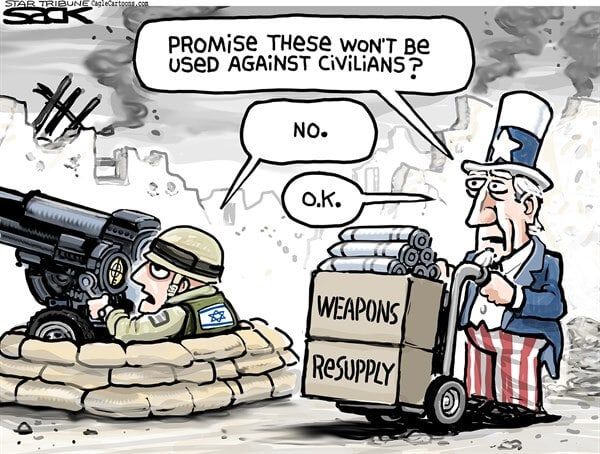Today’s Top Stories
1. YNet talked to a number of foreign journalists who just left Gaza about their experiences. In YNet’s first report, a correspondent described Hamas’ media manipulation.
First, Hamas determined that the organization’s spokesmen could be interviewed only in the the courtyard of Al-Shifa hospital. As a result, long lines of reporters waiting for an interview were created, and during their wait, they witnessed wounded people who arrived to receive treatment. This created the impression Hamas was seeking to convey: a state of immediate emergency and humanitarian disaster.
Secondly, Hamas has never allowed foreign reporters access to military sites attacked by Israel, whether they are bases, rocket-launching sites or other Hamas targets. The dead and wounded of the organization were not captured on film as well, and hence from a media perspective they didn’t even exist. All this served Hamas’ purpose in creating an impression that all the victims were civilians.
Thirdly, it was clear that Hamas was launching rockets out of populated civilian areas, but the organization demanded that the press photographers not document that, so as to not expose their tactic, nor disclose the location of the launchers.
In a second YNet report (must-read), the European journalists discussed what readers back home were making of it all.
Andersson stressed that those who believe the civilian losses are intentional are by far a minority. However, it is the majority that ultimately cares only about the end result of Israel’s many efforts to protect innocent civilians – a fact that does not encourage positive coverage of Israel’s military actions. Denmark is not alone – Israel is having trouble winning over the public in most of western Europe.
2. Gaza’s Greek Orthodox leader, Archbishop Alexios, told the Christian Broadcasting Network that Hamas fired rockets at Israel from the compound of the ancient Church of St. Porphyrius. Read the dispatch or watch the video.
3. The Jerusalem Post reports that the Israeli army’s already prepping for post-war legal battles:
Fearful of the growing international chorus demanding that IDF officers be tried for war crimes allegedly committed against Palestinians in the Gaza Strip, senior military brass has ordered a comprehensive internal probe of the army’s actions during Operation Protective Edge.
On a related note, Professors Asa Kasher and Robbie Sabel discussed legal and ethical angles with Israeli media.

4. If you’re in New York City on Thursday (that’s today!), be sure to come to the Support Israel Rally Against Biased Media. HonestReporting CEO Joe Hyams will be among the speakers.
Where: 58th St. between 8th and 9th Avenues (Columbus Circle)
When: Thursday, August 7, 6:00-9:00 pm
Spread the word, and share this with friends. And be there to support Israel, learn how you can be better informed, and send a message to the news services that the public is holding them accountable. Details at the rally’s Facebook page.
5. Anonymous Sources Run Amok: Anonymous sources require readers to make a leap of faith that’s not necessarily justified.
6. Anyone See a Terrorist? Why couldn’t the New York Times find any Hamas operatives?
Israel and the Palestinians
• The third day of the temporary ceasefire passed quietly as negotiators in Cairo continued working towards a longer-term deal. See live-blogs at Haaretz, Times of Israel, and i24 News (the Jerusalem Post stopped live-blogging). Among today’s top developments:
• British, French and German diplomats proposed a plan to rehabilitate Gaza under international supervision, reports Haaretz. This initiative includes:
- Demilitarizing the strip,
- The return of the Palestinian Authority
- Restoring European monitors to the Rafah crossing at the Gaza-Egypt border
OutsourcingEasing the blockade, which means
Setting up an international mechanism to prevent the entry of prohibited materials to the Strip and ensuring that materials such as cement and iron do not reach the terror organizations but are used only to rehabilitate Gaza.
• Who is a civilian? Here’s an ironic snippet from Donald Macintyre’s Gaza dispatch in The Independent. As Palestinians returning to the remains of their homes in the town of Khuza’a, he was told:
On Sunday, against a background of shelling, a middle-aged resident told us his son had been killed taking part in a Hamas ambush on an Israeli armoured bulldozer. The battle must have spread to this area after the Abu Rujeilas left. Refusing to disavow the fighters, Tamer said: “We are all resistance.”
But Tamer was adamant that his extended family were civilians. Indeed he says that their IDs were checked by Israeli troops at the entrance to the village.
• If the crisis is indeed over, I presume this infographic wouldn’t necessarily represent the IDF’s final stats, but these are the numbers we’re looking at right now.

• Ecuador‘s president cancelled a visit to Israel scheduled for later this year, and announced plans to open an embassy in Ramallah.
Media Angles
• Hamas invited Al-Jazeera reporter Tamer al-Mishal into a terror tunnel, where he talked to operatives and commanders who say they’re ready to continue fighting Israel. Haaretz picked up on the story and embedded a video that hasn’t been translated yet.
Is the tunnel they filmed in really operational as implied? And why did Hamas decide to make itself available to the press now?
• Reporter Bel Trew of the Times of London managed to find a Hamas commander willing to talk. Its not clear if the interview was impromptu or arranged, but the commander, identified only as Abu Laith, spoke the usual trash talk. I was more intrigued by this snippet:
A total of 64 soldiers and three citizens from Israel have also been killed. “It was a completely different conflict to the ones in the past,” he said. “In 2008 [Operation Cast Lead] the airstrike and air surveillance took us by surprise. That war cost us a lot, so we made strategic plans to move the battle from the surface to underground.”
This is why few have seen the fighters or their rockets, which are launched using timers from well-hidden sites in densely packed territory. Rarely do journalists have access to their dead, who are quickly removed from mortuaries for fear of identification.
• Saturation coverage of Gaza, by the numbers: Israel’s Government Press Office, which is responsible for providing media credentials and facilitating access for the press corps said in an email sent to HonestReporting
Since the beginning of Operation Protective Edge on July 8, the Government Press Office (GPO) has dealt with 705 foreign journalists from over 42 countries who came to cover the events. During the Operation Pillar of Defense in November 2012, 303 foreign journalists came to Israel. The journalists joined and reinforced the existing crews regularly working in Israel, who number approximately 750 journalists.
• Sreenivasan Jain explains the backstory of how he and his NDTV crew got its video footage a Hamas crew setting up and firing a rocket next to a hotel full of journalists. Turns out Hamas went to the well once too often: Several days earlier, a rocket had been fired from the exact same spot, so when a blue tent went up, Jain had good reason to be suspicious. If you haven’t seen it yet, here’s the video everybody’s talking about:
• The Lancet has Dennis Prager‘s blood boiling.
• Izzy Lemberg looks at how Big Media handled Gaza and asks, Is journalism dead?
• Obsessive Gaza coverage is fanning anti-Semitism:
Why has the conflict in Gaza caused such a frightening reaction on the streets of Europe? One answer is that the media attention has been excessive, exaggerated beyond all reasonable proportions, and it is this which encourages outbursts of anger by appealing to the public’s emotions. Tiny Israel ranks fifth in the list of foreign countries most reported on by the Guardian. Gaza is an important news story – but the wall-to-wall coverage leaves many scratching their heads. Nobody seems to recall similar attention devoted to the far greater civilian casualties of the UK’s operations in Iraq and Afghanistan.
Why the disproportionate coverage of Israel? “Jews are news” many say, with a shrug. But this obsession with Israel’s conduct tacitly encourages the easy slide into hostility towards Jews.
[T]he reporting gives the false impression that the situation in Gaza, though tragic, is uniquely horrific.
Commentary/Analysis
• Thank you, Dean Obeidallah, for speaking out as a Muslim: Stop the Anti-Semitism when talking Gaza
It doesn’t matter how much you are angered or heartbroken by the image of children being killed in Gaza. And being of Palestinian heritage, I’ve been very aware of the suffering of Palestinian civilians well before social media has recently made this information instantaneously accessible. So I say this as someone who is very supportive of Palestinian humanity.
Anti-Semitism is morally wrong. It’s just like racism, Islamaphobia, homophobia, or any other type of hate. It can’t be tolerated, defended, or contextualized regardless of the form it manifests.
The Sydney Morning Herald‘s Derek Rielly is also alarmed by the rising tide of anti-Semitism.
• From the poison pen of the Minneapolis Star-Tribune‘s Steve Sack (published before the ceasefire went into effect)

• Over at The New Yorker, Ruth Margalit takes a closer look at the IDF’s “Hannibal Directive.” I’m not going to weigh in on this issue, but Margalit collected and linked to some thoughtful pieces.
• Britain’s Chief Rabbi, Ephraim Mirvis, got op-ed space in the Daily Telegraph.
To measure the morality of war by the military might of each party, the number of deaths or the amount of suffering on each side is not merely misguided; it plays into the hands of a ruthless and calculating aggressor.
I often hear reference to “the cycle of violence” in Gaza. Such a phrase suggests a moral equivalence between the sides. In reality, one side is motivated to maximise civilian casualties and has an exterminatory agenda.
• For more commentary, see Amos Harel (Using Gaza lessons to prepare for the next Hezbollah war), Max Blankfeld (State Dept: Short memory, or double standard?), Thane Rosenbaum (The anti-Semitism sweeping Europe), Mort Zuckerman, and a New York Times staff-ed. And a brilliant Wall St Journal staff-ed (click via Google News) deconstructs Britain’s anti-Israel charades.
Britain’s arms-export policy isn’t the main question here. But it’s noteworthy that licenses issued to a revanchist Moscow and a totalitarian Arab state didn’t prompt resignations, public letters of protest or angry tweets from Mr. Clegg and our lady the Baroness, both of whom were in government during the relevant time periods. Arms sales to the Jewish state did.
• To see what the critics are saying, see Mira Bar-Hillel, Yara Hawari, and Seumas Milne.
Image: CC BY flickr/Robert Couse-Baker
For more, see yesterday’s Israel Daily News Stream and join the IDNS on Facebook.


